![]()
![]()
![]()
Use LEFT and RIGHT arrow keys to navigate between flashcards;
Use UP and DOWN arrow keys to flip the card;
H to show hint;
A reads text to speech;
11 Cards in this Set
- Front
- Back
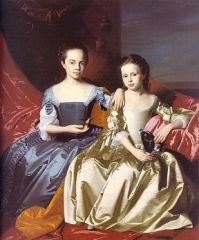
|
Portrait of daughters of Isaac Royall 1758
John Singleton Copley Mary and Elizabeth Royal Oil on canvas Acute perception of the material world Animated countenances Faces of individuals Carefully constructed folds Realistic hands and animals Painting demonstrates Copley's move away from Blackburn toward influence of Feke and signals that Copley has ende his search for his personnel style Full-length figures in strongly raking light Careful attention to physiognomies, costumes Conversation element introduced via pets |
|
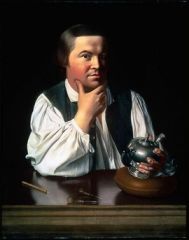
|
Copley, Paul Revere, c. 1769
Oil on canvas Revere is portrayed in his work clothes, he holds a silver teapot and has set aside his tool to view the viewer Liveliness to the portrait Allows people to be on equal footing Portrait of well-known colonial silversmith (& later patriot) Subject shown at work contemplating engraved design on teapot Close engagement with viewer Perfect visualization of American philosophy a man who has gained property through industry |
|
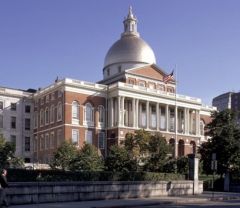
|
Charles Bulfich, Boston state house- 1795
Influenced by Somerset house Red brick highlighted with marble detail Simple clean cut arcade Palladian central arched windows Dome in gold leaf Adamsque delicacy neoclassic |
|
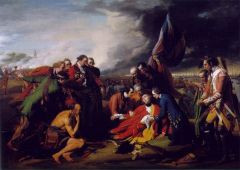
|
West, Death of General Wolfe, 1770
“Modern” subject in “Grand Manner” Death of British General in Battle of Quebec (1759) Rejected idea that subject be classicized Wolfe presented as Christ-like hero Oil on canvas British victory over the French at Quebec Moral lesson great men sacrifices their lives for duty, honor, and patriotism Baroque tradition Went against tradition of painting far past events and painter an event in the last 100 years and had them in contemporary dress instead of roman or Greek clothing |
|
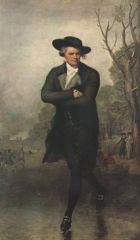
|
Gilbert Stuart, Skater (Rev. William Grant), 1782
Full-length portrait; demonstrated Stuart’s anatomical skills Grant posed skating on Thames River with Windsor Castle in background Portrait/genre scene combined Established Stuarts reputation in London No trace of provincialism Feathery impressionistic brushstrokes |
|
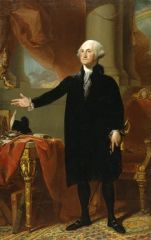
|
Stuart, Lansdowne Washington, 1796
Full-length portrait of Washington commissioned by Lord Lansdowne of England & based on Athenaeum portrait Neoclassical attributes Made several copies, including one for White House Oil on canvas laid to wood painted in Philadelphia Based on an engraving every detail derived from the print Idealization Not a true likeness |
|
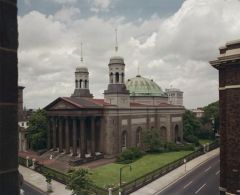
|
Latrobe, Roman Catholic Cathedral, Baltimore, 1804
Commissioned by Bishop John Carroll for largest Catholic diocese in U.S. Latrobe made 2 proposals: neoclassical & Gothic-revival; first chosen, based on Pan-theon; dome 65’ wide Influenced by bank of England New classicism based on Greek architecture and theory Bold primitive purity of Greek forms 2 plans one in gothic one in roman style Stone on a latin cross plan Bishop john Carroll Vaulted side aisles |
|
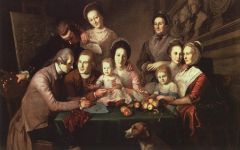
|
Chaeles Willson Peale, Family Group 1770-1773, 1808
Group portrait based on Smibert’s bernuda group and Pratt’s American School Elaborate conversation piece in which a drawling lesson is taking place Oil on Canvas Some training by Copley Studied with West Avoided history paintings Charles gives George a drawling lesson, James looks on, artists mother, wife and infant, sisters Enriched by still life Plaster busts |
|
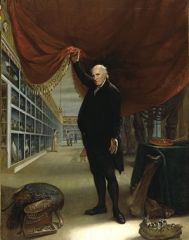
|
Peale, The artist in his museum, 1822
Summation of life's work at 81 Art and science conjoined in education- palette and brushes. Taxidermy kit Sublime discovery contrasted with reflection and instruction Commissioned expressly for the museum Curtain makes a reference to old style paintings Chiaroscuro from the left corner Father and son can be seen in the background father instructing the son Quaker lady in background shocked by mastodon Result is a summation of everything Peale knows Oil on Canvas |
|
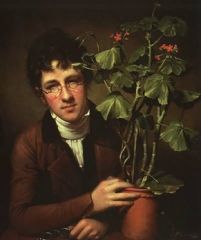
|
Rembrandt Peale, Rubens Peale with geranium, 1801
Son of Charles, studied with West and studied in France Assisted in the museum Portrait of brother Rubens First geranium to be cultivated in America Equal size and equal focus Embracing Reflection of glasses Symbolism of glasses |
|

|
WILLIAM RUSH, Water Nymph and bittern, 1809
Fountain center piece, wood, located outside Latrobe's pumping station Later cast in bronze Criticized for sensuality |

